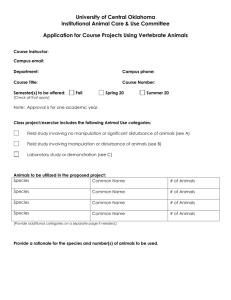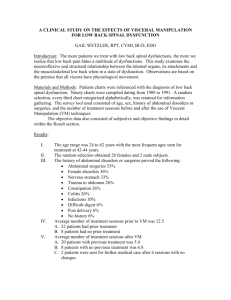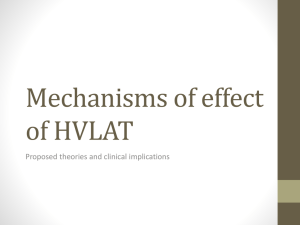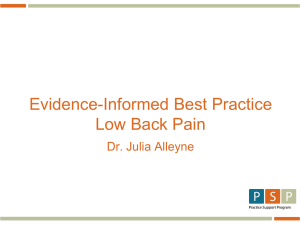Acute Spine Program Powerpoint
advertisement
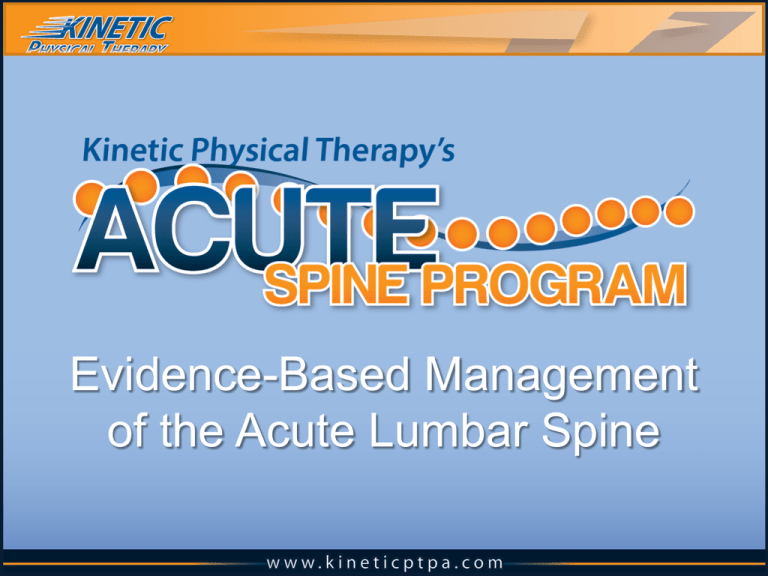
Evidence-Based Management of the Acute Lumbar Spine Our Goal • Early identification of the acute spine – Based on current, high quality research • Timely referral – To an orthopedic manual therapist • Maximize optimal outcomes – Reduce risk of overall disability – Reduce burden on health care system Lumbar Red Flags Spinal Manipulation Clinical Prediction Rule • Flynn et al. Spine 2002 – – – – – Symptoms < 16 days FABQ < 19 No symptoms distal to knee Hip IR > 35o Lumbar hypomobility • 4 or 5 had +LR 24.4 which equals 95% chance of successful outcome A Clinical Prediction Rule to Identify Patients with Low Back Pain Most Likely to Benefit from Spinal Manipulation: A Validation Study Treatment Groups • Childs et al. Ann Intern Med 2004 • Manipulation – First 2 sessions • Manipulation • AROM exercises – Final 3 sessions • Stabilization exercises • Hypothesis – Subjects in manipulation group who fit CPR will have the best outcomes Results Subjects who were positive on the rule and treated with manipulation had greater improvements in pain and disability at 1 week, 4 weeks, and 6 months Validation of Rule 4 or more present: 45% Symptoms < 16 days FABQ < 19 No symptoms distal to knee Hip IR > 35o Lumbar hypomobility 92% The “2 Factor Rule” 45% • Recent onset (< 16 d) • No sx distal to knee 91% Translation to Clinical Practice • Patients with +CPR and received manipulation, the number needed to treat (NNT) for successful outcome: – One week: 1.3 – Four weeks: 1.9 • Lower NNT the more powerful the treatment effect – An NNT < 2 is quite powerful • Antibiotic cocktail to eradicate bacteria – NNT = 1.1 • Lipitor to prevent 1 heart attack – NNT = 16-23 • Crestor to prevent progression of plague build up – NNT = 7 Conclusion • High quality research indicates patient with acute low back pain have a high probability of dramatic success following 2 physical therapy sessions • Optimal outcomes are dependent on: – Identifying patients likely to benefit from manual therapy – Early referral to an evidence-based orthopedic manual therapist • At Kinetic Physical Therapy, we utilize state-of-the-art care by incorporating evidence-based manual therapy, exercise, and the application of a biopsychosocial model in managing cervical and lumbar disorders Supporting Article Summaries • Flynn et al. Spine2002 The objective of this study is to develop a clinical prediction rule (CPR) for identifying patients with low back pain who improve with spinal manipulation. A clinical prediction rule with five variables was identified. The presence of four of five of these variables increased the probability of success with manipulation from 45% to 95%. Overall, it appears patients with low back pain likely to respond to manipulation can be accurately identified. • Childs et al. Annals of Int Med 2005 The objective of this study was to validate a previous clinical prediction rule (Flynn et al. 2002) for identifying patients with low back pain who improve with spinal manipulation. Patients were randomly assigned to receive manipulation plus exercise or exercise alone by a physical therapist for four weeks. A patient who was positive on the clinical prediction rule and received a manipulation has a 92% chance of a successful outcome with an associated number needed to treat of 1.9 at four weeks.
